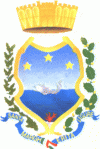Santa Margherita Ligure (Santa Margherita Ligure)
 |
The presence of a Roman settlement has not been definitely proven. The burgh, known as Pescino, was devastated by Rothari in 641 and by the Saracens in the 10th century. Later it was a fief of the Fieschi family until 1229, when it was acquired by the Republic of Genoa.
In 1432 it was attacked by the fleet of Venice and in 1549, together with Rapallo, by that of Turgut.
In 1813, under the Napoleonic domination, the two burghs of Pescino and Corte were unified as Porto Napoleone. Two years later it was annexed to the Kingdom of Sardinia as the commune of Santa Margherita Ligure. In 1861 it became part of the newly unified Kingdom of Italy.
Connected by rail in the 20th century, Santa Margherita became a renowned tourist resort after World War II.
Map - Santa Margherita Ligure (Santa Margherita Ligure)
Map
Country - Italy
 |
 |
| Flag of Italy | |
Italy was the native place of many civilizations such as the Italic peoples and the Etruscans, while due to its central geographic location in Southern Europe and the Mediterranean, the country has also historically been home to myriad peoples and cultures, who immigrated to the peninsula throughout history. The Latins, native of central Italy, formed the Roman Kingdom in the 8th century BC, which eventually became a republic with a government of the Senate and the People. The Roman Republic initially conquered and assimilated its neighbours on the Italian peninsula, eventually expanding and conquering a large part of Europe, North Africa and Western Asia. By the first century BC, the Roman Empire emerged as the dominant power in the Mediterranean Basin and became a leading cultural, political and religious centre, inaugurating the Pax Romana, a period of more than 200 years during which Italy's law, technology, economy, art, and literature developed.
Currency / Language
| ISO | Currency | Symbol | Significant figures |
|---|---|---|---|
| EUR | Euro | € | 2 |
| ISO | Language |
|---|---|
| CA | Catalan language |
| CO | Corsican language |
| FR | French language |
| DE | German language |
| IT | Italian language |
| SC | Sardinian language |
| SL | Slovene language |















